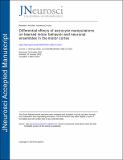Differential effects of astrocyte manipulations on learned motor behavior and neuronal ensembles in the motor cortex
Author(s)
Delepine, Chloe; Shih, Jennifer; Li, Keji; Gaudeaux, Pierre; Sur, Mriganka
DownloadPublished version (5.297Mb)
Publisher with Creative Commons License
Publisher with Creative Commons License
Creative Commons Attribution
Terms of use
Metadata
Show full item recordAbstract
<jats:p>While motor cortex is crucial for learning precise and reliable movements, whether and how astrocytes contribute to its plasticity and function during motor learning is unknown. Here we report that astrocyte-specific manipulations in primary motor cortex (M1) during a lever push task alter motor learning and execution, as well as the underlying neuronal population coding. Mice that express decreased levels of the astrocyte glutamate transporter GLT1 show impaired and variable movement trajectories, while mice with increased astrocyte Gq signaling show decreased performance rates, delayed response times, and impaired trajectories. In both groups, which include male and female mice, M1 neurons have altered inter-neuronal correlations and impaired population representations of task parameters, including response time and movement trajectories. RNA sequencing further supports a role for M1 astrocytes in motor learning and shows changes in astrocytic expression of glutamate transporter genes, GABA transporter genes, and extracellular matrix protein genes in mice that have acquired this learned behavior. Thus, astrocytes coordinate M1 neuronal activity during motor learning, and our results suggest that this contributes to learned movement execution and dexterity through mechanisms that include regulation of neurotransmitter transport and calcium signaling.</jats:p><jats:p><jats:bold>SIGNIFICANCE STATEMENT:</jats:bold></jats:p><jats:p>We demonstrate for the first time that in the primary motor cortex (M1) of mice, astrocyte function is critical for coordinating neuronal population activity during motor learning. We demonstrate that knockdown of astrocyte glutamate transporter GLT1 affects specific components of learning, such as smooth trajectory formation. Altering astrocyte calcium signaling by activation of Gq-DREADD upregulates GLT1 and affects other components of learning, such as response rates and reaction times as well as trajectory smoothness. In both manipulations, neuronal activity in motor cortex is dysregulated, but in different ways. Thus, astrocytes have a crucial role in motor learning via their influence on motor cortex neurons, and they do so by mechanisms that include regulation of glutamate transport and calcium signals.</jats:p>
Date issued
2023-03-09Department
Massachusetts Institute of Technology. Department of Brain and Cognitive SciencesJournal
The Journal of Neuroscience
Publisher
Society for Neuroscience
Citation
Delepine, Chloe, Shih, Jennifer, Li, Keji, Gaudeaux, Pierre and Sur, Mriganka. 2023. "Differential effects of astrocyte manipulations on learned motor behavior and neuronal ensembles in the motor cortex." The Journal of Neuroscience.
Version: Final published version